Taxation Law: Consequences for ABC Sports Pty Ltd and John
VerifiedAdded on 2021/05/31
|13
|3445
|33
Homework Assignment
AI Summary
This taxation law assignment examines the tax consequences for ABC Sports Pty Ltd and John, covering various aspects of Australian tax law. The assignment addresses issues related to assessable income, deductions, and fringe benefits tax (FBT), citing relevant legislation such as the ITAA 1997 and FBTAA 1986, and case law like "Federal Commissioner of Taxation v Wiener (1978)" and "Californian Oil Products Ltd v Federal Commissioner of Taxation (1934)." It analyzes whether compensation for contract termination is taxable income, the deductibility of travel expenses, and the classification of relocation costs as capital expenses. The assignment also explores the tax implications of employee benefits, such as school fees and car fringe benefits, as well as the capital gains tax (CGT) consequences of personal use assets like a yacht and a horse, referencing relevant sections like section 108-C, section 118-10 (3), and CGT event D1.
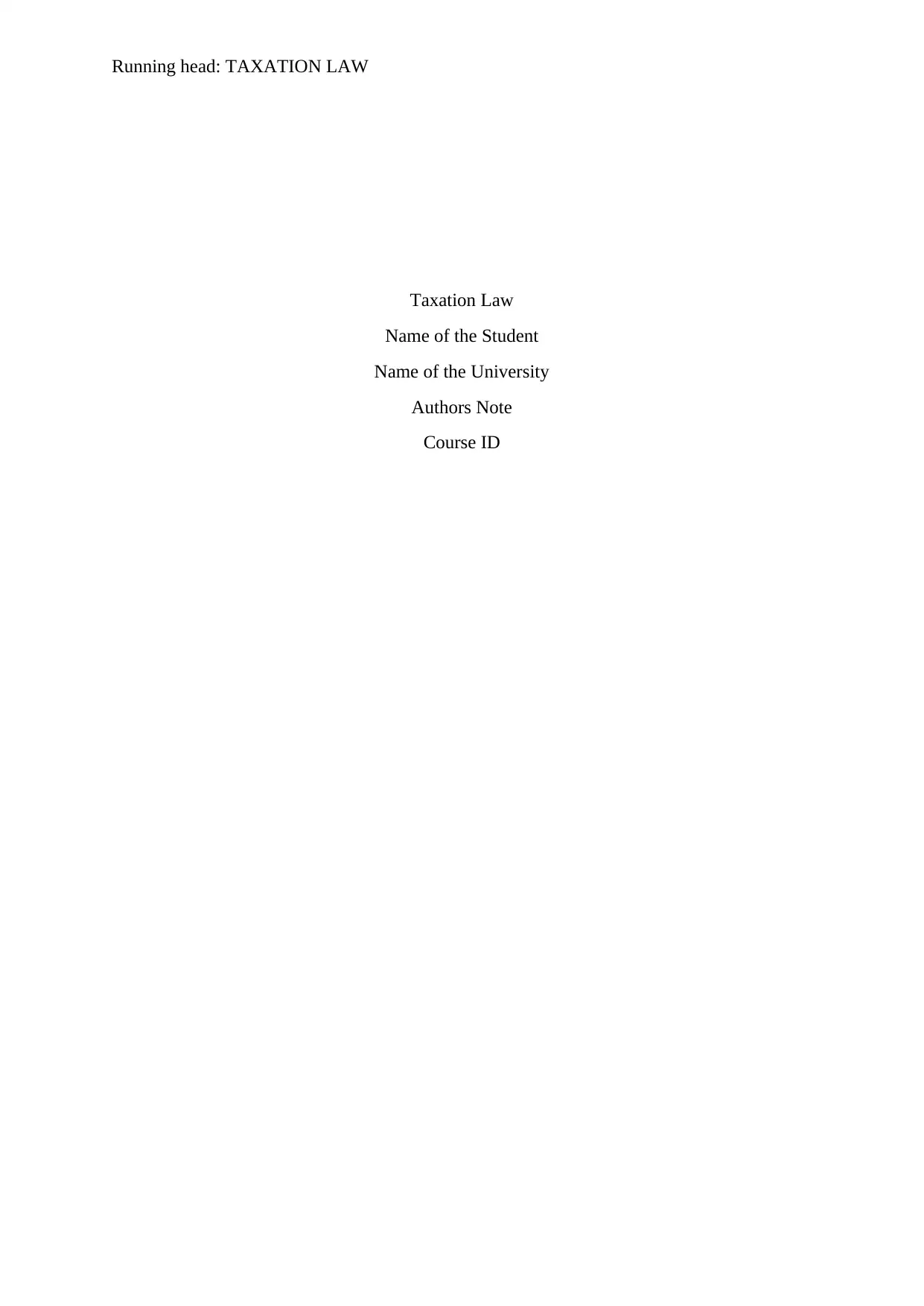
Running head: TAXATION LAW
Taxation Law
Name of the Student
Name of the University
Authors Note
Course ID
Taxation Law
Name of the Student
Name of the University
Authors Note
Course ID
Paraphrase This Document
Need a fresh take? Get an instant paraphrase of this document with our AI Paraphraser
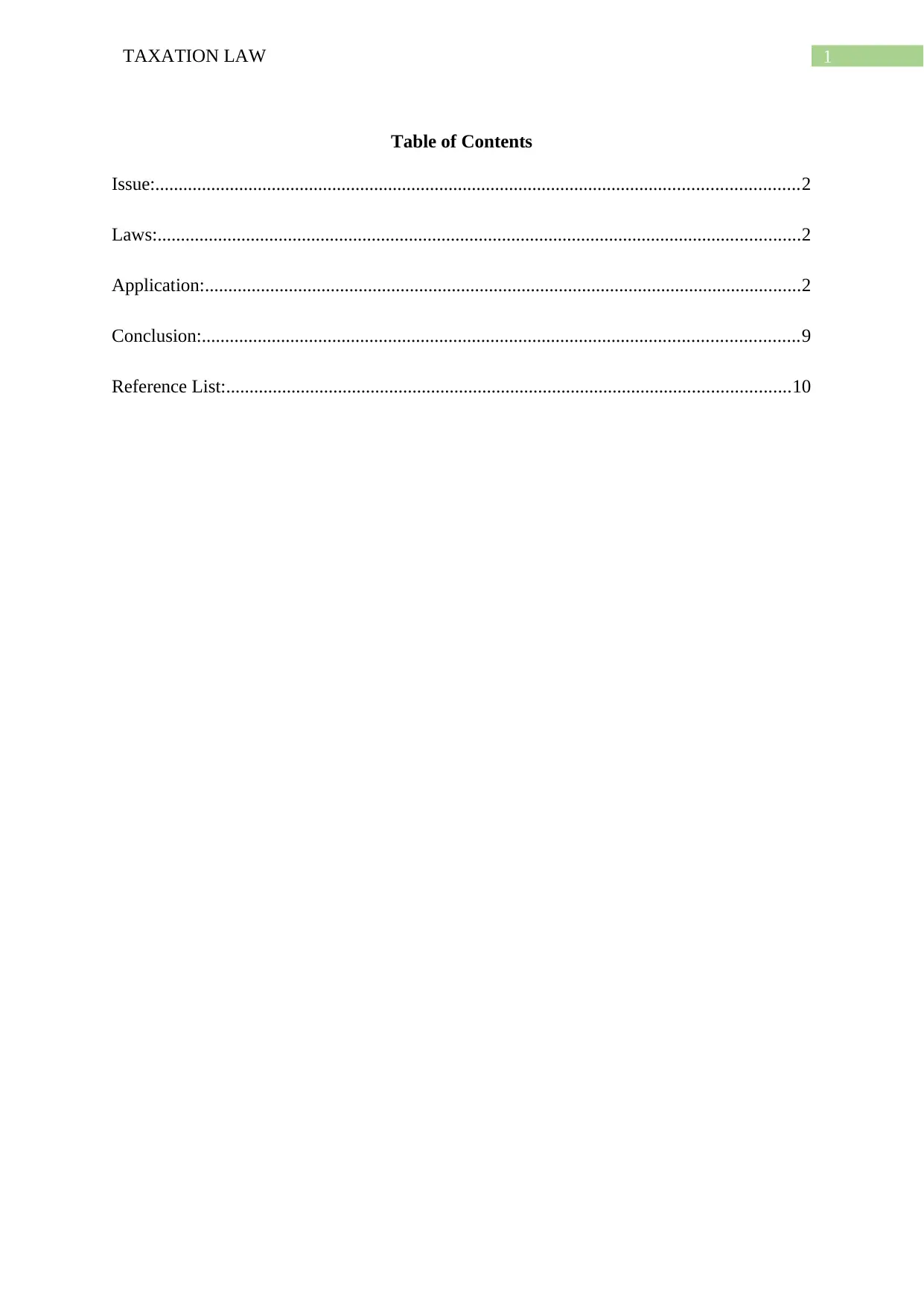
1TAXATION LAW
Table of Contents
Issue:..........................................................................................................................................2
Laws:..........................................................................................................................................2
Application:................................................................................................................................2
Conclusion:................................................................................................................................9
Reference List:.........................................................................................................................10
Table of Contents
Issue:..........................................................................................................................................2
Laws:..........................................................................................................................................2
Application:................................................................................................................................2
Conclusion:................................................................................................................................9
Reference List:.........................................................................................................................10
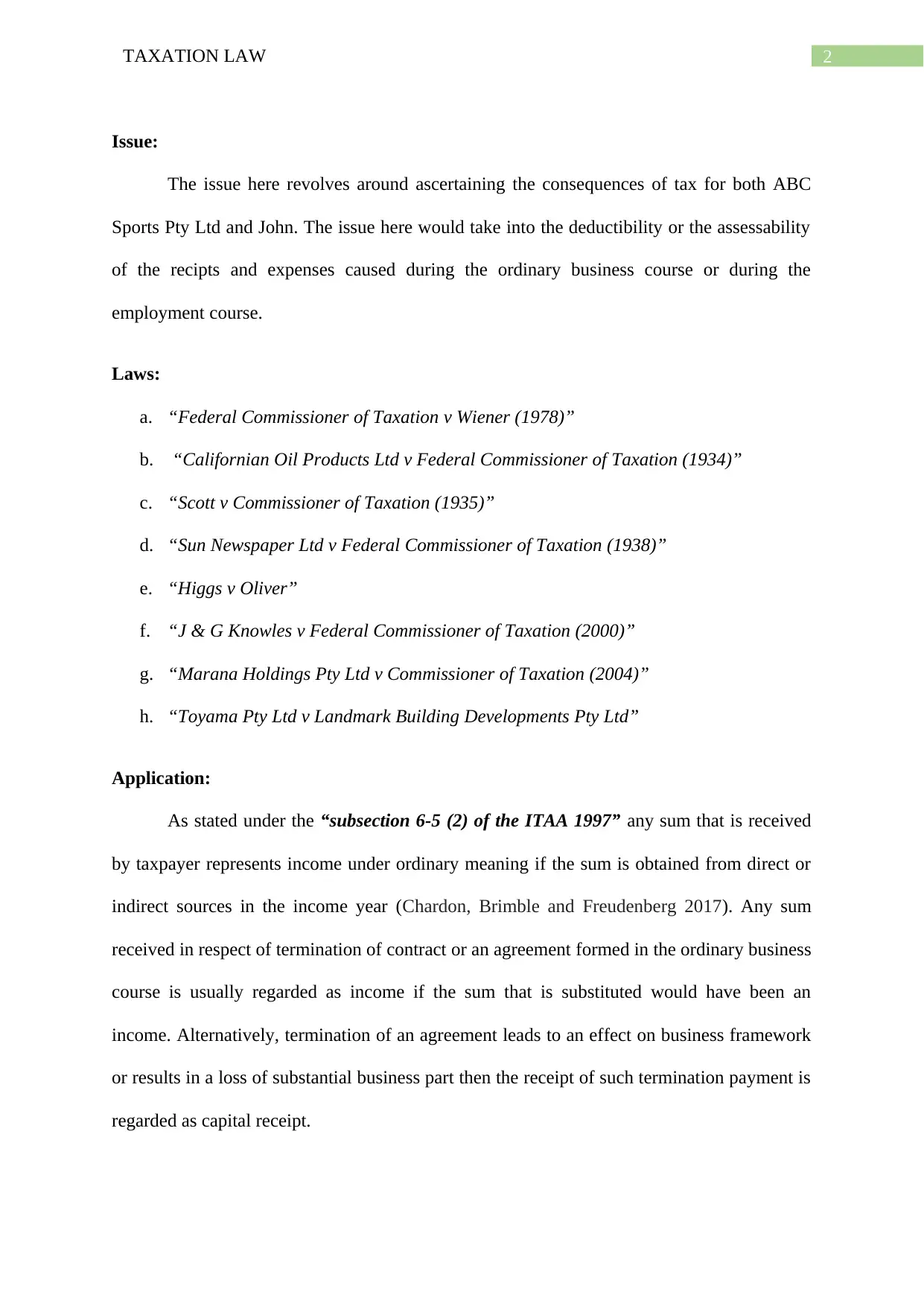
2TAXATION LAW
Issue:
The issue here revolves around ascertaining the consequences of tax for both ABC
Sports Pty Ltd and John. The issue here would take into the deductibility or the assessability
of the recipts and expenses caused during the ordinary business course or during the
employment course.
Laws:
a. “Federal Commissioner of Taxation v Wiener (1978)”
b. “Californian Oil Products Ltd v Federal Commissioner of Taxation (1934)”
c. “Scott v Commissioner of Taxation (1935)”
d. “Sun Newspaper Ltd v Federal Commissioner of Taxation (1938)”
e. “Higgs v Oliver”
f. “J & G Knowles v Federal Commissioner of Taxation (2000)”
g. “Marana Holdings Pty Ltd v Commissioner of Taxation (2004)”
h. “Toyama Pty Ltd v Landmark Building Developments Pty Ltd”
Application:
As stated under the “subsection 6-5 (2) of the ITAA 1997” any sum that is received
by taxpayer represents income under ordinary meaning if the sum is obtained from direct or
indirect sources in the income year (Chardon, Brimble and Freudenberg 2017). Any sum
received in respect of termination of contract or an agreement formed in the ordinary business
course is usually regarded as income if the sum that is substituted would have been an
income. Alternatively, termination of an agreement leads to an effect on business framework
or results in a loss of substantial business part then the receipt of such termination payment is
regarded as capital receipt.
Issue:
The issue here revolves around ascertaining the consequences of tax for both ABC
Sports Pty Ltd and John. The issue here would take into the deductibility or the assessability
of the recipts and expenses caused during the ordinary business course or during the
employment course.
Laws:
a. “Federal Commissioner of Taxation v Wiener (1978)”
b. “Californian Oil Products Ltd v Federal Commissioner of Taxation (1934)”
c. “Scott v Commissioner of Taxation (1935)”
d. “Sun Newspaper Ltd v Federal Commissioner of Taxation (1938)”
e. “Higgs v Oliver”
f. “J & G Knowles v Federal Commissioner of Taxation (2000)”
g. “Marana Holdings Pty Ltd v Commissioner of Taxation (2004)”
h. “Toyama Pty Ltd v Landmark Building Developments Pty Ltd”
Application:
As stated under the “subsection 6-5 (2) of the ITAA 1997” any sum that is received
by taxpayer represents income under ordinary meaning if the sum is obtained from direct or
indirect sources in the income year (Chardon, Brimble and Freudenberg 2017). Any sum
received in respect of termination of contract or an agreement formed in the ordinary business
course is usually regarded as income if the sum that is substituted would have been an
income. Alternatively, termination of an agreement leads to an effect on business framework
or results in a loss of substantial business part then the receipt of such termination payment is
regarded as capital receipt.
⊘ This is a preview!⊘
Do you want full access?
Subscribe today to unlock all pages.

Trusted by 1+ million students worldwide
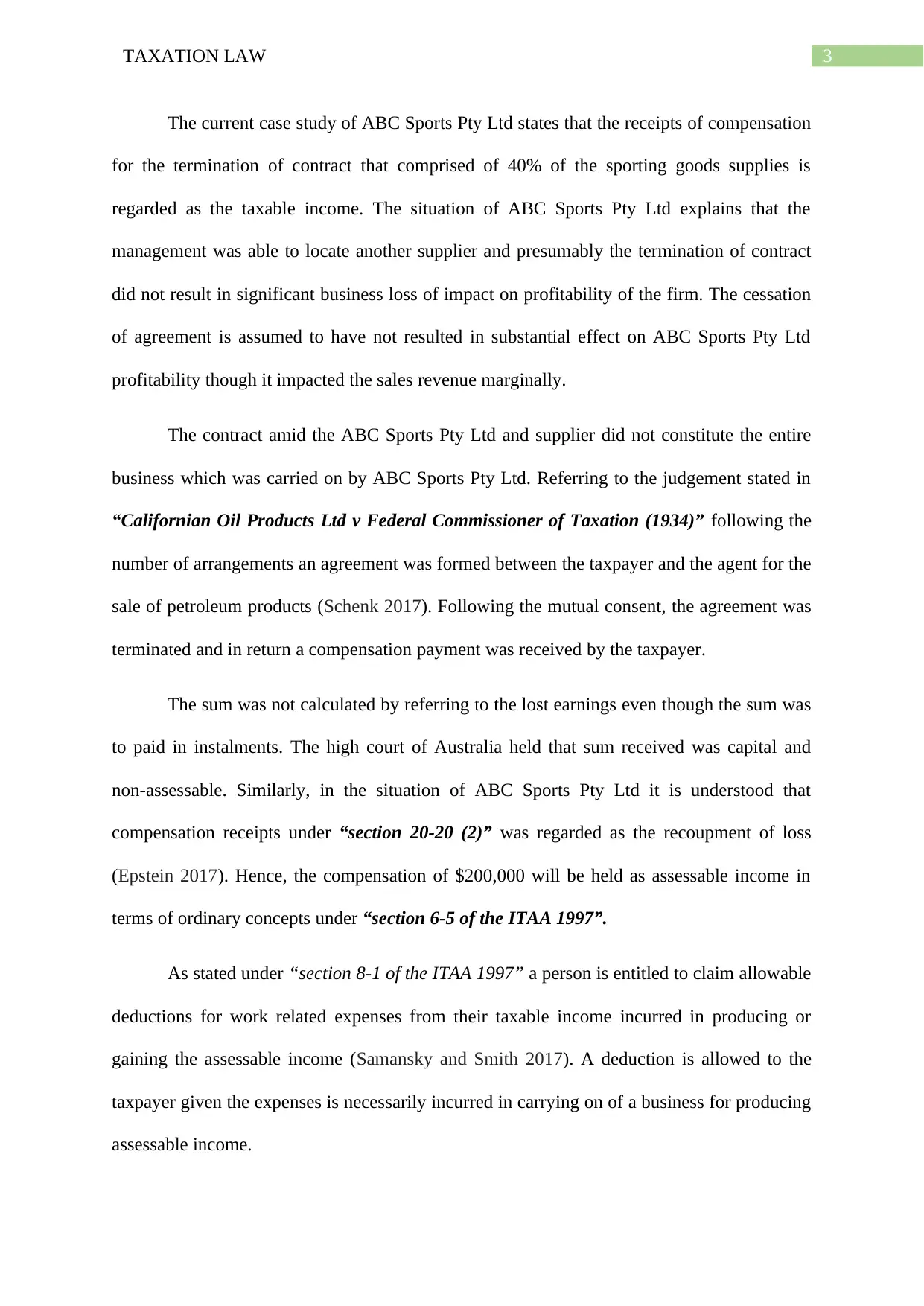
3TAXATION LAW
The current case study of ABC Sports Pty Ltd states that the receipts of compensation
for the termination of contract that comprised of 40% of the sporting goods supplies is
regarded as the taxable income. The situation of ABC Sports Pty Ltd explains that the
management was able to locate another supplier and presumably the termination of contract
did not result in significant business loss of impact on profitability of the firm. The cessation
of agreement is assumed to have not resulted in substantial effect on ABC Sports Pty Ltd
profitability though it impacted the sales revenue marginally.
The contract amid the ABC Sports Pty Ltd and supplier did not constitute the entire
business which was carried on by ABC Sports Pty Ltd. Referring to the judgement stated in
“Californian Oil Products Ltd v Federal Commissioner of Taxation (1934)” following the
number of arrangements an agreement was formed between the taxpayer and the agent for the
sale of petroleum products (Schenk 2017). Following the mutual consent, the agreement was
terminated and in return a compensation payment was received by the taxpayer.
The sum was not calculated by referring to the lost earnings even though the sum was
to paid in instalments. The high court of Australia held that sum received was capital and
non-assessable. Similarly, in the situation of ABC Sports Pty Ltd it is understood that
compensation receipts under “section 20-20 (2)” was regarded as the recoupment of loss
(Epstein 2017). Hence, the compensation of $200,000 will be held as assessable income in
terms of ordinary concepts under “section 6-5 of the ITAA 1997”.
As stated under “section 8-1 of the ITAA 1997” a person is entitled to claim allowable
deductions for work related expenses from their taxable income incurred in producing or
gaining the assessable income (Samansky and Smith 2017). A deduction is allowed to the
taxpayer given the expenses is necessarily incurred in carrying on of a business for producing
assessable income.
The current case study of ABC Sports Pty Ltd states that the receipts of compensation
for the termination of contract that comprised of 40% of the sporting goods supplies is
regarded as the taxable income. The situation of ABC Sports Pty Ltd explains that the
management was able to locate another supplier and presumably the termination of contract
did not result in significant business loss of impact on profitability of the firm. The cessation
of agreement is assumed to have not resulted in substantial effect on ABC Sports Pty Ltd
profitability though it impacted the sales revenue marginally.
The contract amid the ABC Sports Pty Ltd and supplier did not constitute the entire
business which was carried on by ABC Sports Pty Ltd. Referring to the judgement stated in
“Californian Oil Products Ltd v Federal Commissioner of Taxation (1934)” following the
number of arrangements an agreement was formed between the taxpayer and the agent for the
sale of petroleum products (Schenk 2017). Following the mutual consent, the agreement was
terminated and in return a compensation payment was received by the taxpayer.
The sum was not calculated by referring to the lost earnings even though the sum was
to paid in instalments. The high court of Australia held that sum received was capital and
non-assessable. Similarly, in the situation of ABC Sports Pty Ltd it is understood that
compensation receipts under “section 20-20 (2)” was regarded as the recoupment of loss
(Epstein 2017). Hence, the compensation of $200,000 will be held as assessable income in
terms of ordinary concepts under “section 6-5 of the ITAA 1997”.
As stated under “section 8-1 of the ITAA 1997” a person is entitled to claim allowable
deductions for work related expenses from their taxable income incurred in producing or
gaining the assessable income (Samansky and Smith 2017). A deduction is allowed to the
taxpayer given the expenses is necessarily incurred in carrying on of a business for producing
assessable income.
Paraphrase This Document
Need a fresh take? Get an instant paraphrase of this document with our AI Paraphraser
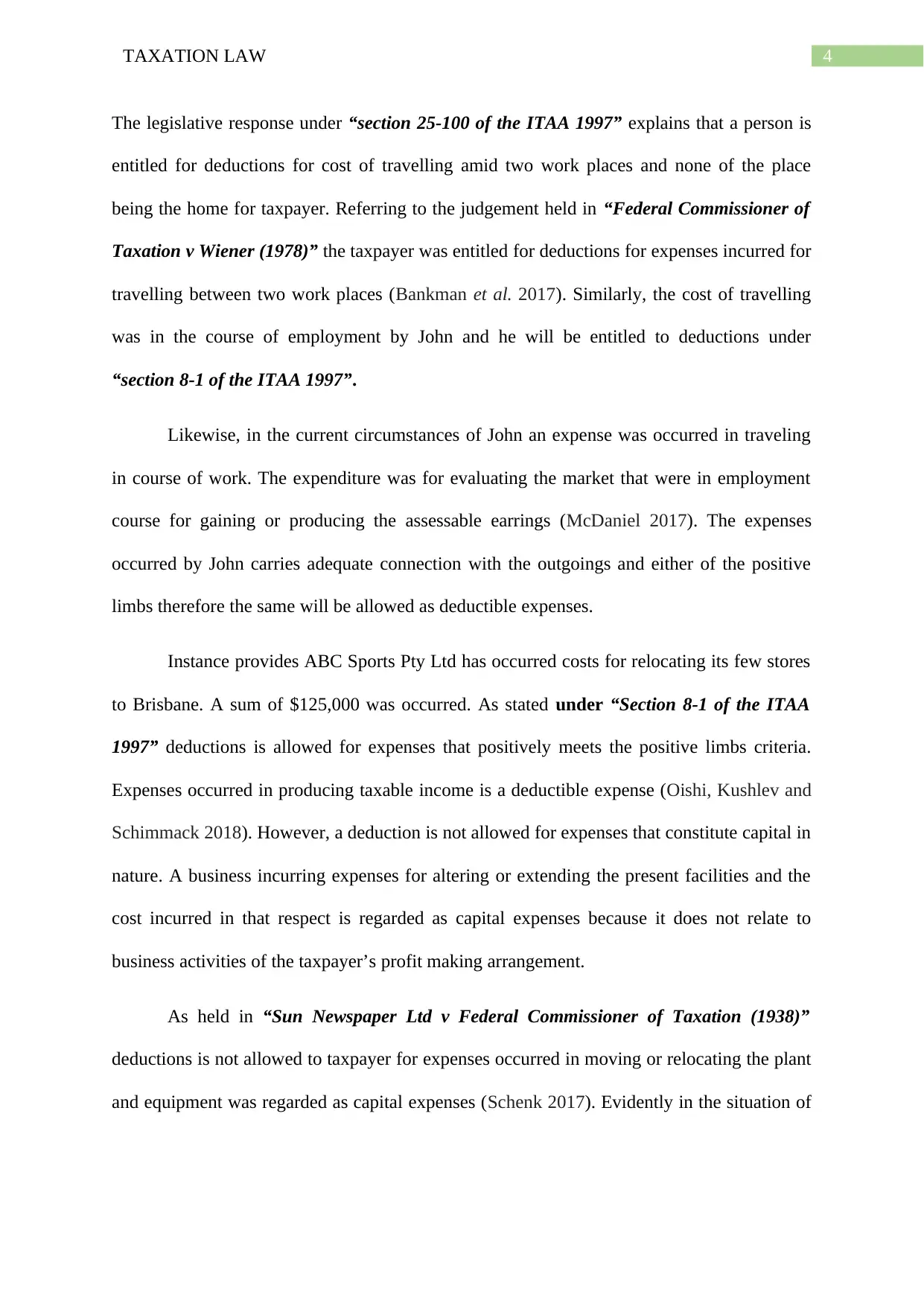
4TAXATION LAW
The legislative response under “section 25-100 of the ITAA 1997” explains that a person is
entitled for deductions for cost of travelling amid two work places and none of the place
being the home for taxpayer. Referring to the judgement held in “Federal Commissioner of
Taxation v Wiener (1978)” the taxpayer was entitled for deductions for expenses incurred for
travelling between two work places (Bankman et al. 2017). Similarly, the cost of travelling
was in the course of employment by John and he will be entitled to deductions under
“section 8-1 of the ITAA 1997”.
Likewise, in the current circumstances of John an expense was occurred in traveling
in course of work. The expenditure was for evaluating the market that were in employment
course for gaining or producing the assessable earrings (McDaniel 2017). The expenses
occurred by John carries adequate connection with the outgoings and either of the positive
limbs therefore the same will be allowed as deductible expenses.
Instance provides ABC Sports Pty Ltd has occurred costs for relocating its few stores
to Brisbane. A sum of $125,000 was occurred. As stated under “Section 8-1 of the ITAA
1997” deductions is allowed for expenses that positively meets the positive limbs criteria.
Expenses occurred in producing taxable income is a deductible expense (Oishi, Kushlev and
Schimmack 2018). However, a deduction is not allowed for expenses that constitute capital in
nature. A business incurring expenses for altering or extending the present facilities and the
cost incurred in that respect is regarded as capital expenses because it does not relate to
business activities of the taxpayer’s profit making arrangement.
As held in “Sun Newspaper Ltd v Federal Commissioner of Taxation (1938)”
deductions is not allowed to taxpayer for expenses occurred in moving or relocating the plant
and equipment was regarded as capital expenses (Schenk 2017). Evidently in the situation of
The legislative response under “section 25-100 of the ITAA 1997” explains that a person is
entitled for deductions for cost of travelling amid two work places and none of the place
being the home for taxpayer. Referring to the judgement held in “Federal Commissioner of
Taxation v Wiener (1978)” the taxpayer was entitled for deductions for expenses incurred for
travelling between two work places (Bankman et al. 2017). Similarly, the cost of travelling
was in the course of employment by John and he will be entitled to deductions under
“section 8-1 of the ITAA 1997”.
Likewise, in the current circumstances of John an expense was occurred in traveling
in course of work. The expenditure was for evaluating the market that were in employment
course for gaining or producing the assessable earrings (McDaniel 2017). The expenses
occurred by John carries adequate connection with the outgoings and either of the positive
limbs therefore the same will be allowed as deductible expenses.
Instance provides ABC Sports Pty Ltd has occurred costs for relocating its few stores
to Brisbane. A sum of $125,000 was occurred. As stated under “Section 8-1 of the ITAA
1997” deductions is allowed for expenses that positively meets the positive limbs criteria.
Expenses occurred in producing taxable income is a deductible expense (Oishi, Kushlev and
Schimmack 2018). However, a deduction is not allowed for expenses that constitute capital in
nature. A business incurring expenses for altering or extending the present facilities and the
cost incurred in that respect is regarded as capital expenses because it does not relate to
business activities of the taxpayer’s profit making arrangement.
As held in “Sun Newspaper Ltd v Federal Commissioner of Taxation (1938)”
deductions is not allowed to taxpayer for expenses occurred in moving or relocating the plant
and equipment was regarded as capital expenses (Schenk 2017). Evidently in the situation of
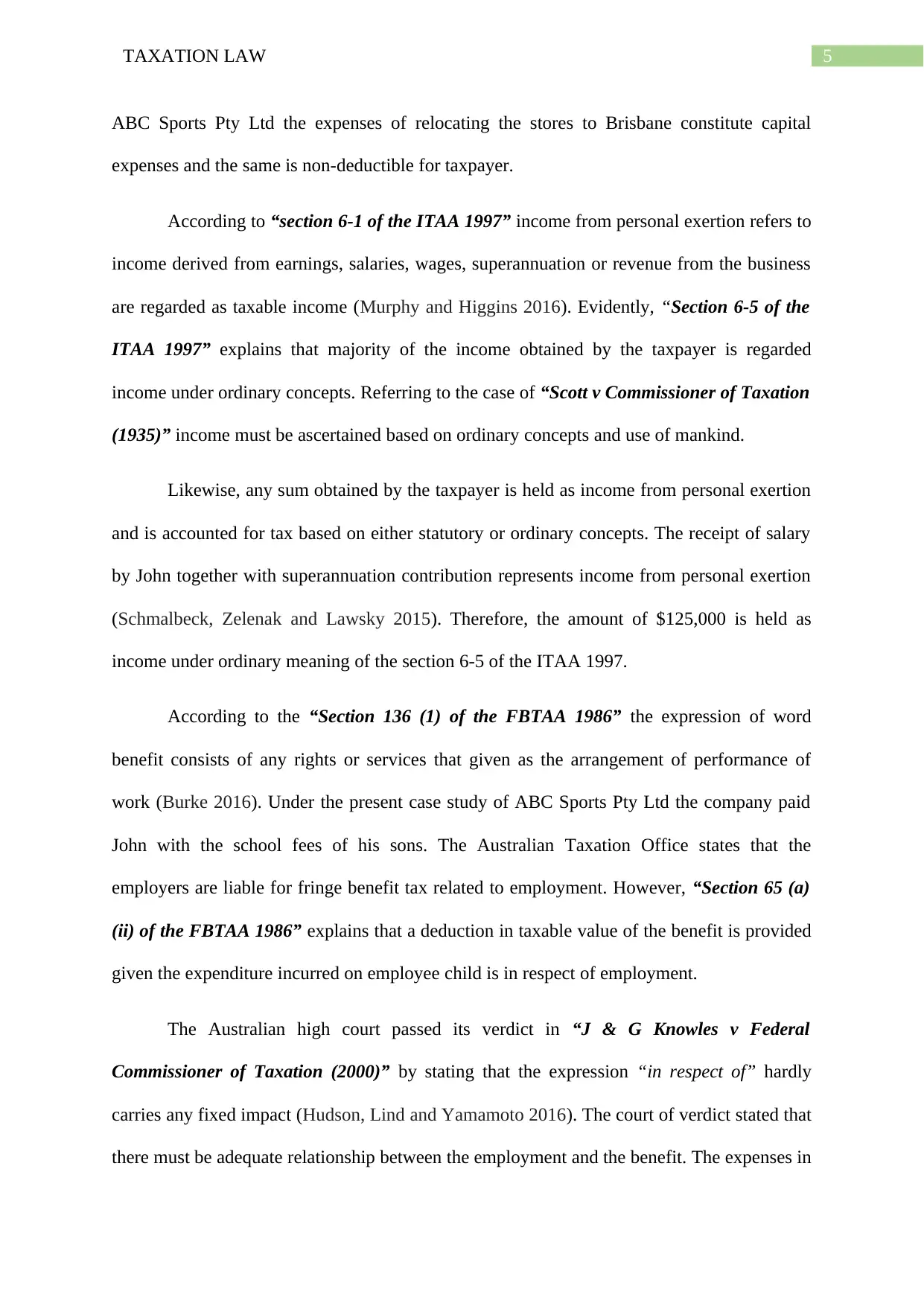
5TAXATION LAW
ABC Sports Pty Ltd the expenses of relocating the stores to Brisbane constitute capital
expenses and the same is non-deductible for taxpayer.
According to “section 6-1 of the ITAA 1997” income from personal exertion refers to
income derived from earnings, salaries, wages, superannuation or revenue from the business
are regarded as taxable income (Murphy and Higgins 2016). Evidently, “Section 6-5 of the
ITAA 1997” explains that majority of the income obtained by the taxpayer is regarded
income under ordinary concepts. Referring to the case of “Scott v Commissioner of Taxation
(1935)” income must be ascertained based on ordinary concepts and use of mankind.
Likewise, any sum obtained by the taxpayer is held as income from personal exertion
and is accounted for tax based on either statutory or ordinary concepts. The receipt of salary
by John together with superannuation contribution represents income from personal exertion
(Schmalbeck, Zelenak and Lawsky 2015). Therefore, the amount of $125,000 is held as
income under ordinary meaning of the section 6-5 of the ITAA 1997.
According to the “Section 136 (1) of the FBTAA 1986” the expression of word
benefit consists of any rights or services that given as the arrangement of performance of
work (Burke 2016). Under the present case study of ABC Sports Pty Ltd the company paid
John with the school fees of his sons. The Australian Taxation Office states that the
employers are liable for fringe benefit tax related to employment. However, “Section 65 (a)
(ii) of the FBTAA 1986” explains that a deduction in taxable value of the benefit is provided
given the expenditure incurred on employee child is in respect of employment.
The Australian high court passed its verdict in “J & G Knowles v Federal
Commissioner of Taxation (2000)” by stating that the expression “in respect of” hardly
carries any fixed impact (Hudson, Lind and Yamamoto 2016). The court of verdict stated that
there must be adequate relationship between the employment and the benefit. The expenses in
ABC Sports Pty Ltd the expenses of relocating the stores to Brisbane constitute capital
expenses and the same is non-deductible for taxpayer.
According to “section 6-1 of the ITAA 1997” income from personal exertion refers to
income derived from earnings, salaries, wages, superannuation or revenue from the business
are regarded as taxable income (Murphy and Higgins 2016). Evidently, “Section 6-5 of the
ITAA 1997” explains that majority of the income obtained by the taxpayer is regarded
income under ordinary concepts. Referring to the case of “Scott v Commissioner of Taxation
(1935)” income must be ascertained based on ordinary concepts and use of mankind.
Likewise, any sum obtained by the taxpayer is held as income from personal exertion
and is accounted for tax based on either statutory or ordinary concepts. The receipt of salary
by John together with superannuation contribution represents income from personal exertion
(Schmalbeck, Zelenak and Lawsky 2015). Therefore, the amount of $125,000 is held as
income under ordinary meaning of the section 6-5 of the ITAA 1997.
According to the “Section 136 (1) of the FBTAA 1986” the expression of word
benefit consists of any rights or services that given as the arrangement of performance of
work (Burke 2016). Under the present case study of ABC Sports Pty Ltd the company paid
John with the school fees of his sons. The Australian Taxation Office states that the
employers are liable for fringe benefit tax related to employment. However, “Section 65 (a)
(ii) of the FBTAA 1986” explains that a deduction in taxable value of the benefit is provided
given the expenditure incurred on employee child is in respect of employment.
The Australian high court passed its verdict in “J & G Knowles v Federal
Commissioner of Taxation (2000)” by stating that the expression “in respect of” hardly
carries any fixed impact (Hudson, Lind and Yamamoto 2016). The court of verdict stated that
there must be adequate relationship between the employment and the benefit. The expenses in
⊘ This is a preview!⊘
Do you want full access?
Subscribe today to unlock all pages.

Trusted by 1+ million students worldwide
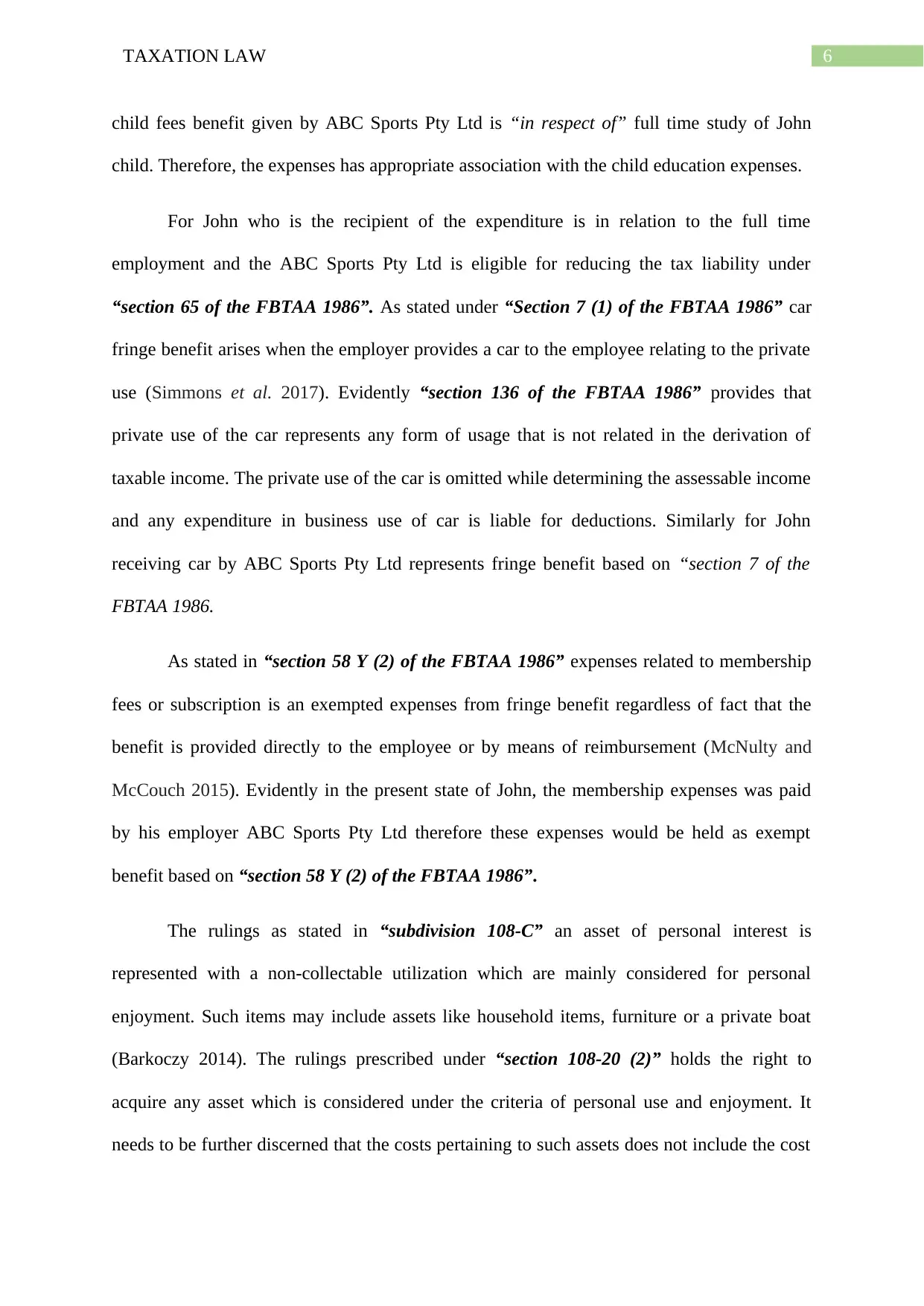
6TAXATION LAW
child fees benefit given by ABC Sports Pty Ltd is “in respect of” full time study of John
child. Therefore, the expenses has appropriate association with the child education expenses.
For John who is the recipient of the expenditure is in relation to the full time
employment and the ABC Sports Pty Ltd is eligible for reducing the tax liability under
“section 65 of the FBTAA 1986”. As stated under “Section 7 (1) of the FBTAA 1986” car
fringe benefit arises when the employer provides a car to the employee relating to the private
use (Simmons et al. 2017). Evidently “section 136 of the FBTAA 1986” provides that
private use of the car represents any form of usage that is not related in the derivation of
taxable income. The private use of the car is omitted while determining the assessable income
and any expenditure in business use of car is liable for deductions. Similarly for John
receiving car by ABC Sports Pty Ltd represents fringe benefit based on “section 7 of the
FBTAA 1986.
As stated in “section 58 Y (2) of the FBTAA 1986” expenses related to membership
fees or subscription is an exempted expenses from fringe benefit regardless of fact that the
benefit is provided directly to the employee or by means of reimbursement (McNulty and
McCouch 2015). Evidently in the present state of John, the membership expenses was paid
by his employer ABC Sports Pty Ltd therefore these expenses would be held as exempt
benefit based on “section 58 Y (2) of the FBTAA 1986”.
The rulings as stated in “subdivision 108-C” an asset of personal interest is
represented with a non-collectable utilization which are mainly considered for personal
enjoyment. Such items may include assets like household items, furniture or a private boat
(Barkoczy 2014). The rulings prescribed under “section 108-20 (2)” holds the right to
acquire any asset which is considered under the criteria of personal use and enjoyment. It
needs to be further discerned that the costs pertaining to such assets does not include the cost
child fees benefit given by ABC Sports Pty Ltd is “in respect of” full time study of John
child. Therefore, the expenses has appropriate association with the child education expenses.
For John who is the recipient of the expenditure is in relation to the full time
employment and the ABC Sports Pty Ltd is eligible for reducing the tax liability under
“section 65 of the FBTAA 1986”. As stated under “Section 7 (1) of the FBTAA 1986” car
fringe benefit arises when the employer provides a car to the employee relating to the private
use (Simmons et al. 2017). Evidently “section 136 of the FBTAA 1986” provides that
private use of the car represents any form of usage that is not related in the derivation of
taxable income. The private use of the car is omitted while determining the assessable income
and any expenditure in business use of car is liable for deductions. Similarly for John
receiving car by ABC Sports Pty Ltd represents fringe benefit based on “section 7 of the
FBTAA 1986.
As stated in “section 58 Y (2) of the FBTAA 1986” expenses related to membership
fees or subscription is an exempted expenses from fringe benefit regardless of fact that the
benefit is provided directly to the employee or by means of reimbursement (McNulty and
McCouch 2015). Evidently in the present state of John, the membership expenses was paid
by his employer ABC Sports Pty Ltd therefore these expenses would be held as exempt
benefit based on “section 58 Y (2) of the FBTAA 1986”.
The rulings as stated in “subdivision 108-C” an asset of personal interest is
represented with a non-collectable utilization which are mainly considered for personal
enjoyment. Such items may include assets like household items, furniture or a private boat
(Barkoczy 2014). The rulings prescribed under “section 108-20 (2)” holds the right to
acquire any asset which is considered under the criteria of personal use and enjoyment. It
needs to be further discerned that the costs pertaining to such assets does not include the cost
Paraphrase This Document
Need a fresh take? Get an instant paraphrase of this document with our AI Paraphraser
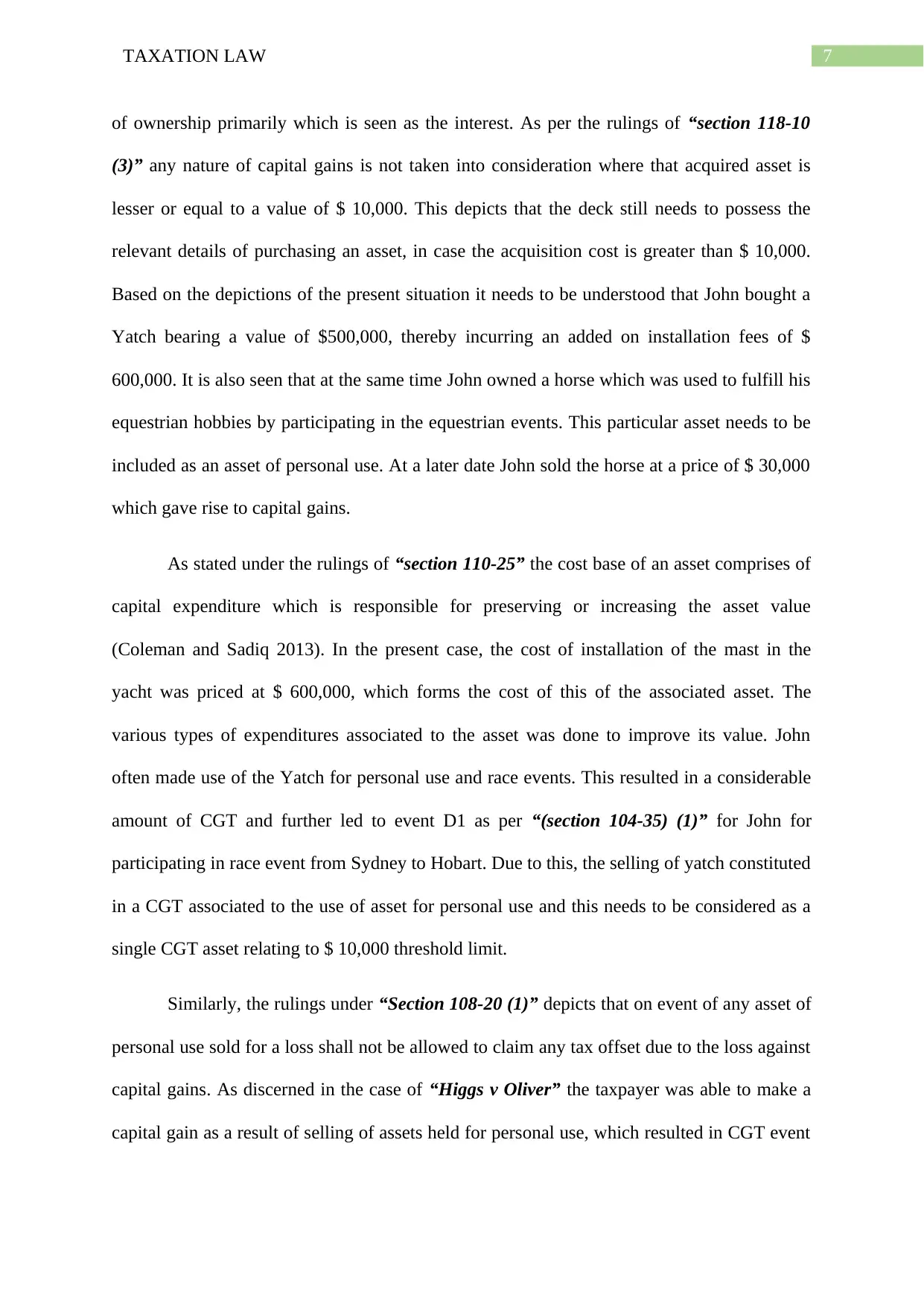
7TAXATION LAW
of ownership primarily which is seen as the interest. As per the rulings of “section 118-10
(3)” any nature of capital gains is not taken into consideration where that acquired asset is
lesser or equal to a value of $ 10,000. This depicts that the deck still needs to possess the
relevant details of purchasing an asset, in case the acquisition cost is greater than $ 10,000.
Based on the depictions of the present situation it needs to be understood that John bought a
Yatch bearing a value of $500,000, thereby incurring an added on installation fees of $
600,000. It is also seen that at the same time John owned a horse which was used to fulfill his
equestrian hobbies by participating in the equestrian events. This particular asset needs to be
included as an asset of personal use. At a later date John sold the horse at a price of $ 30,000
which gave rise to capital gains.
As stated under the rulings of “section 110-25” the cost base of an asset comprises of
capital expenditure which is responsible for preserving or increasing the asset value
(Coleman and Sadiq 2013). In the present case, the cost of installation of the mast in the
yacht was priced at $ 600,000, which forms the cost of this of the associated asset. The
various types of expenditures associated to the asset was done to improve its value. John
often made use of the Yatch for personal use and race events. This resulted in a considerable
amount of CGT and further led to event D1 as per “(section 104-35) (1)” for John for
participating in race event from Sydney to Hobart. Due to this, the selling of yatch constituted
in a CGT associated to the use of asset for personal use and this needs to be considered as a
single CGT asset relating to $ 10,000 threshold limit.
Similarly, the rulings under “Section 108-20 (1)” depicts that on event of any asset of
personal use sold for a loss shall not be allowed to claim any tax offset due to the loss against
capital gains. As discerned in the case of “Higgs v Oliver” the taxpayer was able to make a
capital gain as a result of selling of assets held for personal use, which resulted in CGT event
of ownership primarily which is seen as the interest. As per the rulings of “section 118-10
(3)” any nature of capital gains is not taken into consideration where that acquired asset is
lesser or equal to a value of $ 10,000. This depicts that the deck still needs to possess the
relevant details of purchasing an asset, in case the acquisition cost is greater than $ 10,000.
Based on the depictions of the present situation it needs to be understood that John bought a
Yatch bearing a value of $500,000, thereby incurring an added on installation fees of $
600,000. It is also seen that at the same time John owned a horse which was used to fulfill his
equestrian hobbies by participating in the equestrian events. This particular asset needs to be
included as an asset of personal use. At a later date John sold the horse at a price of $ 30,000
which gave rise to capital gains.
As stated under the rulings of “section 110-25” the cost base of an asset comprises of
capital expenditure which is responsible for preserving or increasing the asset value
(Coleman and Sadiq 2013). In the present case, the cost of installation of the mast in the
yacht was priced at $ 600,000, which forms the cost of this of the associated asset. The
various types of expenditures associated to the asset was done to improve its value. John
often made use of the Yatch for personal use and race events. This resulted in a considerable
amount of CGT and further led to event D1 as per “(section 104-35) (1)” for John for
participating in race event from Sydney to Hobart. Due to this, the selling of yatch constituted
in a CGT associated to the use of asset for personal use and this needs to be considered as a
single CGT asset relating to $ 10,000 threshold limit.
Similarly, the rulings under “Section 108-20 (1)” depicts that on event of any asset of
personal use sold for a loss shall not be allowed to claim any tax offset due to the loss against
capital gains. As discerned in the case of “Higgs v Oliver” the taxpayer was able to make a
capital gain as a result of selling of assets held for personal use, which resulted in CGT event
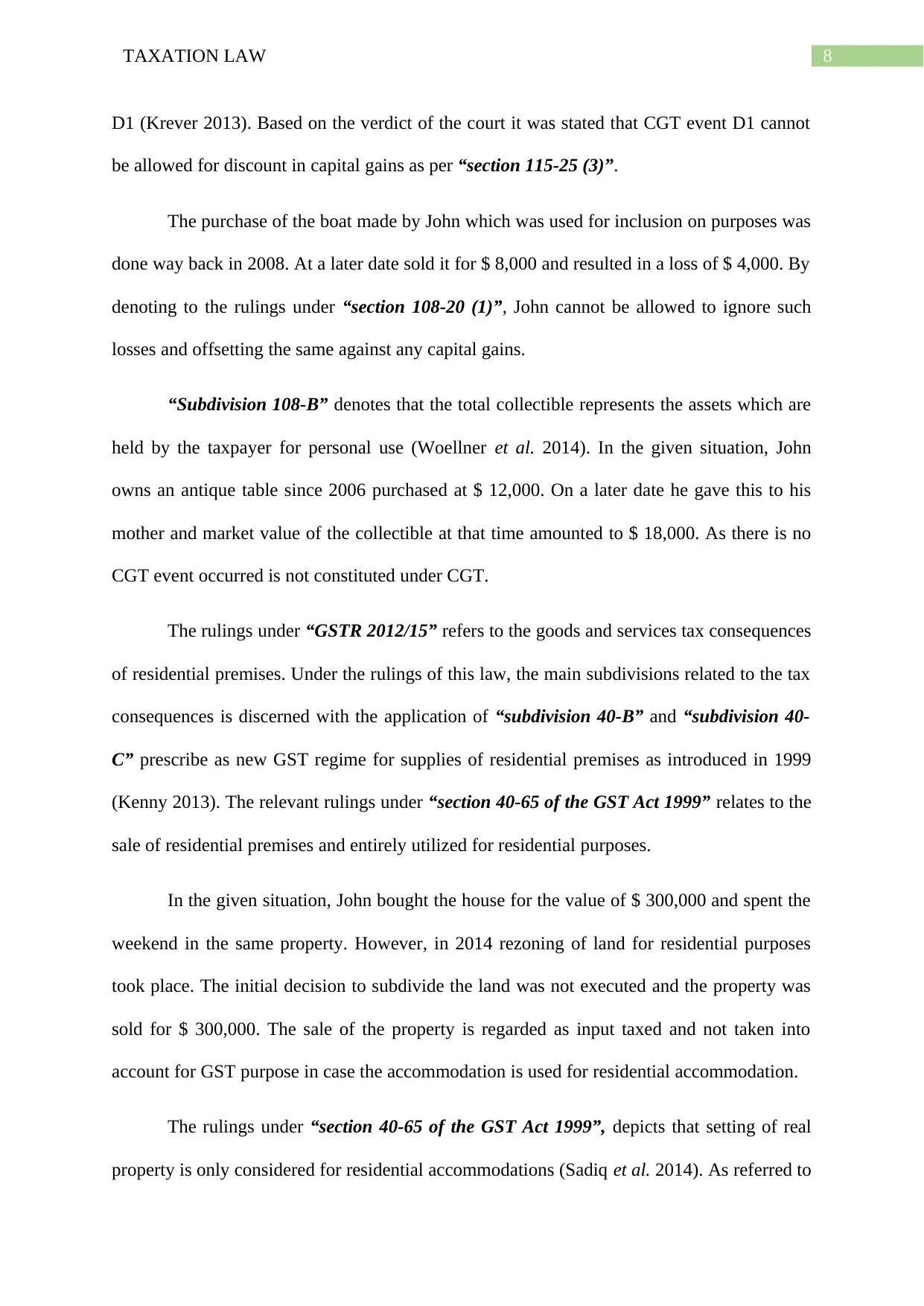
8TAXATION LAW
D1 (Krever 2013). Based on the verdict of the court it was stated that CGT event D1 cannot
be allowed for discount in capital gains as per “section 115-25 (3)”.
The purchase of the boat made by John which was used for inclusion on purposes was
done way back in 2008. At a later date sold it for $ 8,000 and resulted in a loss of $ 4,000. By
denoting to the rulings under “section 108-20 (1)”, John cannot be allowed to ignore such
losses and offsetting the same against any capital gains.
“Subdivision 108-B” denotes that the total collectible represents the assets which are
held by the taxpayer for personal use (Woellner et al. 2014). In the given situation, John
owns an antique table since 2006 purchased at $ 12,000. On a later date he gave this to his
mother and market value of the collectible at that time amounted to $ 18,000. As there is no
CGT event occurred is not constituted under CGT.
The rulings under “GSTR 2012/15” refers to the goods and services tax consequences
of residential premises. Under the rulings of this law, the main subdivisions related to the tax
consequences is discerned with the application of “subdivision 40-B” and “subdivision 40-
C” prescribe as new GST regime for supplies of residential premises as introduced in 1999
(Kenny 2013). The relevant rulings under “section 40-65 of the GST Act 1999” relates to the
sale of residential premises and entirely utilized for residential purposes.
In the given situation, John bought the house for the value of $ 300,000 and spent the
weekend in the same property. However, in 2014 rezoning of land for residential purposes
took place. The initial decision to subdivide the land was not executed and the property was
sold for $ 300,000. The sale of the property is regarded as input taxed and not taken into
account for GST purpose in case the accommodation is used for residential accommodation.
The rulings under “section 40-65 of the GST Act 1999”, depicts that setting of real
property is only considered for residential accommodations (Sadiq et al. 2014). As referred to
D1 (Krever 2013). Based on the verdict of the court it was stated that CGT event D1 cannot
be allowed for discount in capital gains as per “section 115-25 (3)”.
The purchase of the boat made by John which was used for inclusion on purposes was
done way back in 2008. At a later date sold it for $ 8,000 and resulted in a loss of $ 4,000. By
denoting to the rulings under “section 108-20 (1)”, John cannot be allowed to ignore such
losses and offsetting the same against any capital gains.
“Subdivision 108-B” denotes that the total collectible represents the assets which are
held by the taxpayer for personal use (Woellner et al. 2014). In the given situation, John
owns an antique table since 2006 purchased at $ 12,000. On a later date he gave this to his
mother and market value of the collectible at that time amounted to $ 18,000. As there is no
CGT event occurred is not constituted under CGT.
The rulings under “GSTR 2012/15” refers to the goods and services tax consequences
of residential premises. Under the rulings of this law, the main subdivisions related to the tax
consequences is discerned with the application of “subdivision 40-B” and “subdivision 40-
C” prescribe as new GST regime for supplies of residential premises as introduced in 1999
(Kenny 2013). The relevant rulings under “section 40-65 of the GST Act 1999” relates to the
sale of residential premises and entirely utilized for residential purposes.
In the given situation, John bought the house for the value of $ 300,000 and spent the
weekend in the same property. However, in 2014 rezoning of land for residential purposes
took place. The initial decision to subdivide the land was not executed and the property was
sold for $ 300,000. The sale of the property is regarded as input taxed and not taken into
account for GST purpose in case the accommodation is used for residential accommodation.
The rulings under “section 40-65 of the GST Act 1999”, depicts that setting of real
property is only considered for residential accommodations (Sadiq et al. 2014). As referred to
⊘ This is a preview!⊘
Do you want full access?
Subscribe today to unlock all pages.

Trusted by 1+ million students worldwide
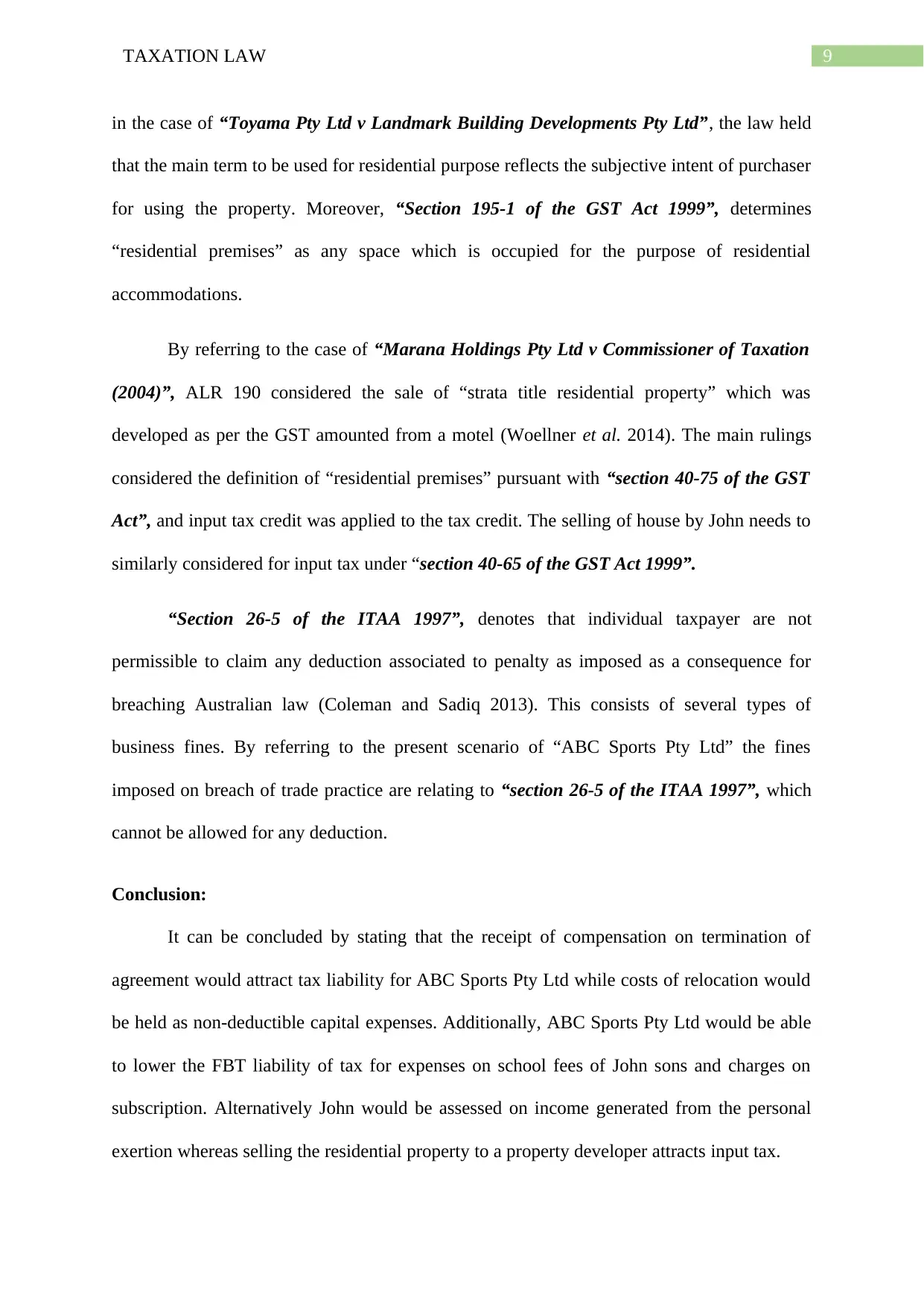
9TAXATION LAW
in the case of “Toyama Pty Ltd v Landmark Building Developments Pty Ltd”, the law held
that the main term to be used for residential purpose reflects the subjective intent of purchaser
for using the property. Moreover, “Section 195-1 of the GST Act 1999”, determines
“residential premises” as any space which is occupied for the purpose of residential
accommodations.
By referring to the case of “Marana Holdings Pty Ltd v Commissioner of Taxation
(2004)”, ALR 190 considered the sale of “strata title residential property” which was
developed as per the GST amounted from a motel (Woellner et al. 2014). The main rulings
considered the definition of “residential premises” pursuant with “section 40-75 of the GST
Act”, and input tax credit was applied to the tax credit. The selling of house by John needs to
similarly considered for input tax under “section 40-65 of the GST Act 1999”.
“Section 26-5 of the ITAA 1997”, denotes that individual taxpayer are not
permissible to claim any deduction associated to penalty as imposed as a consequence for
breaching Australian law (Coleman and Sadiq 2013). This consists of several types of
business fines. By referring to the present scenario of “ABC Sports Pty Ltd” the fines
imposed on breach of trade practice are relating to “section 26-5 of the ITAA 1997”, which
cannot be allowed for any deduction.
Conclusion:
It can be concluded by stating that the receipt of compensation on termination of
agreement would attract tax liability for ABC Sports Pty Ltd while costs of relocation would
be held as non-deductible capital expenses. Additionally, ABC Sports Pty Ltd would be able
to lower the FBT liability of tax for expenses on school fees of John sons and charges on
subscription. Alternatively John would be assessed on income generated from the personal
exertion whereas selling the residential property to a property developer attracts input tax.
in the case of “Toyama Pty Ltd v Landmark Building Developments Pty Ltd”, the law held
that the main term to be used for residential purpose reflects the subjective intent of purchaser
for using the property. Moreover, “Section 195-1 of the GST Act 1999”, determines
“residential premises” as any space which is occupied for the purpose of residential
accommodations.
By referring to the case of “Marana Holdings Pty Ltd v Commissioner of Taxation
(2004)”, ALR 190 considered the sale of “strata title residential property” which was
developed as per the GST amounted from a motel (Woellner et al. 2014). The main rulings
considered the definition of “residential premises” pursuant with “section 40-75 of the GST
Act”, and input tax credit was applied to the tax credit. The selling of house by John needs to
similarly considered for input tax under “section 40-65 of the GST Act 1999”.
“Section 26-5 of the ITAA 1997”, denotes that individual taxpayer are not
permissible to claim any deduction associated to penalty as imposed as a consequence for
breaching Australian law (Coleman and Sadiq 2013). This consists of several types of
business fines. By referring to the present scenario of “ABC Sports Pty Ltd” the fines
imposed on breach of trade practice are relating to “section 26-5 of the ITAA 1997”, which
cannot be allowed for any deduction.
Conclusion:
It can be concluded by stating that the receipt of compensation on termination of
agreement would attract tax liability for ABC Sports Pty Ltd while costs of relocation would
be held as non-deductible capital expenses. Additionally, ABC Sports Pty Ltd would be able
to lower the FBT liability of tax for expenses on school fees of John sons and charges on
subscription. Alternatively John would be assessed on income generated from the personal
exertion whereas selling the residential property to a property developer attracts input tax.
Paraphrase This Document
Need a fresh take? Get an instant paraphrase of this document with our AI Paraphraser

10TAXATION LAW
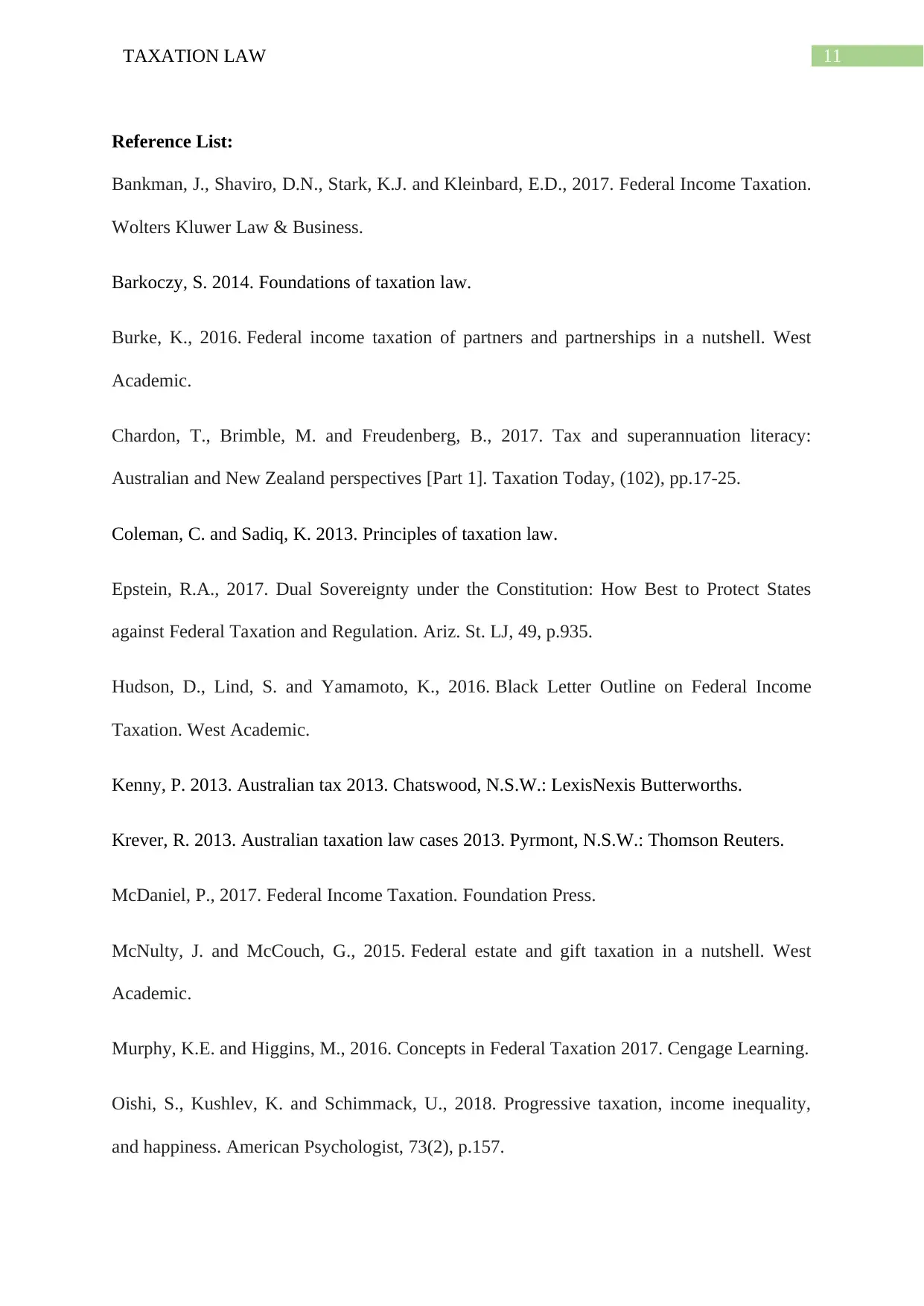
11TAXATION LAW
Reference List:
Bankman, J., Shaviro, D.N., Stark, K.J. and Kleinbard, E.D., 2017. Federal Income Taxation.
Wolters Kluwer Law & Business.
Barkoczy, S. 2014. Foundations of taxation law.
Burke, K., 2016. Federal income taxation of partners and partnerships in a nutshell. West
Academic.
Chardon, T., Brimble, M. and Freudenberg, B., 2017. Tax and superannuation literacy:
Australian and New Zealand perspectives [Part 1]. Taxation Today, (102), pp.17-25.
Coleman, C. and Sadiq, K. 2013. Principles of taxation law.
Epstein, R.A., 2017. Dual Sovereignty under the Constitution: How Best to Protect States
against Federal Taxation and Regulation. Ariz. St. LJ, 49, p.935.
Hudson, D., Lind, S. and Yamamoto, K., 2016. Black Letter Outline on Federal Income
Taxation. West Academic.
Kenny, P. 2013. Australian tax 2013. Chatswood, N.S.W.: LexisNexis Butterworths.
Krever, R. 2013. Australian taxation law cases 2013. Pyrmont, N.S.W.: Thomson Reuters.
McDaniel, P., 2017. Federal Income Taxation. Foundation Press.
McNulty, J. and McCouch, G., 2015. Federal estate and gift taxation in a nutshell. West
Academic.
Murphy, K.E. and Higgins, M., 2016. Concepts in Federal Taxation 2017. Cengage Learning.
Oishi, S., Kushlev, K. and Schimmack, U., 2018. Progressive taxation, income inequality,
and happiness. American Psychologist, 73(2), p.157.
Reference List:
Bankman, J., Shaviro, D.N., Stark, K.J. and Kleinbard, E.D., 2017. Federal Income Taxation.
Wolters Kluwer Law & Business.
Barkoczy, S. 2014. Foundations of taxation law.
Burke, K., 2016. Federal income taxation of partners and partnerships in a nutshell. West
Academic.
Chardon, T., Brimble, M. and Freudenberg, B., 2017. Tax and superannuation literacy:
Australian and New Zealand perspectives [Part 1]. Taxation Today, (102), pp.17-25.
Coleman, C. and Sadiq, K. 2013. Principles of taxation law.
Epstein, R.A., 2017. Dual Sovereignty under the Constitution: How Best to Protect States
against Federal Taxation and Regulation. Ariz. St. LJ, 49, p.935.
Hudson, D., Lind, S. and Yamamoto, K., 2016. Black Letter Outline on Federal Income
Taxation. West Academic.
Kenny, P. 2013. Australian tax 2013. Chatswood, N.S.W.: LexisNexis Butterworths.
Krever, R. 2013. Australian taxation law cases 2013. Pyrmont, N.S.W.: Thomson Reuters.
McDaniel, P., 2017. Federal Income Taxation. Foundation Press.
McNulty, J. and McCouch, G., 2015. Federal estate and gift taxation in a nutshell. West
Academic.
Murphy, K.E. and Higgins, M., 2016. Concepts in Federal Taxation 2017. Cengage Learning.
Oishi, S., Kushlev, K. and Schimmack, U., 2018. Progressive taxation, income inequality,
and happiness. American Psychologist, 73(2), p.157.
⊘ This is a preview!⊘
Do you want full access?
Subscribe today to unlock all pages.

Trusted by 1+ million students worldwide
1 out of 13
Related Documents
Your All-in-One AI-Powered Toolkit for Academic Success.
+13062052269
info@desklib.com
Available 24*7 on WhatsApp / Email
![[object Object]](/_next/static/media/star-bottom.7253800d.svg)
Unlock your academic potential
Copyright © 2020–2025 A2Z Services. All Rights Reserved. Developed and managed by ZUCOL.





